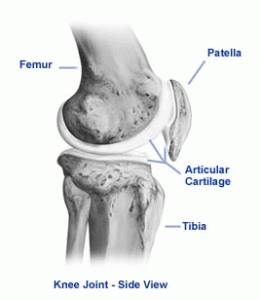Articular cartilage is the tissue coating the surface of joints on our bodies. It’s a complex connective tissue, covering the bone surfaces and protecting the bone from mechanical impacts. It is key in increasing the lubrication and reducing wear, stress and friction on the bones during movement.
The only cell type found in cartilage are the chondrocytes, which are embedded within a dense extracellular matrix (ECM) comprised of tissue fluid and macromolecules such as collagen, proteoglycans, glycoproteins, and non-collagenous proteins.
Cartilage is a stratified tissue, comprising of different layers depending on the localization and ECM composition. Along the vertical axis the articular cartilage is macroscopically divided into three zones depending on the distance from the surface (the superficial, mid and deep zone). The mechanic properties vary between the zones. For instance the superficial zone is key for resistance to shear stress, therefore contains a higher and dense amount of collagen fibrils. On the other hand the middle zone is specialized in bear compression, and its level of collagen decrease, predominating GAG. Finally, the main function of the deep zone is to enhance the tissue attachment to bone with the extended collagen fibrils.
 http://ajs.sagepub.com/content/26/2/309
http://ajs.sagepub.com/content/26/2/309
Chondrocyte arrangement and morphology differ in each zone, the surface chondrocytes are flattened, cells in the middle zone are randomly organised with a rounded shape, and in the deeper zone they are distributed in columns with a rounded morphology (3). Moreover, the ECM is also microscopically subdivided into pericellular, territorial and interterritorial regions. The variation in composition of each region explains the contrast in their function, for instance, the pericellular region contributes to mechanotransduction when applying loads, whilst the territorial region’s main role is to provide protection and withstand to mechanical stress and load. In summary, cartilage is a zonally complex dense avascular tissue with limited repair capacity. This makes it a difficult tissue to study and animal models are often employed to understand cartilage development and ageing in a biomechanically relevant context.
